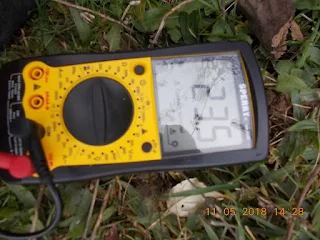I went to Family Shooter's Corral to verify the sights on the two guns I plan to take deer hunting. One will be the primary. The other is a back-up, either for me or for guests.
The Mossberg 500 that Mrs ERJ bought for me the first Christmas we were married has a 20", smooth-bore slug barrel on it and a Tasco Red Dot scope with a 3MOA dot. I was happy to see it hit a half inch high and a half inch to the right at fifty yards. Done!!!
Kubota sold me his Mossberg 500 when he was short of money. Better to keep the hardware in the family.
The slugs it liked last year were hard to find so I bought a similar offering from the same vendor.
The first shot was six inches high at 100 yards. The second shot was three inches high. Adjustments were made.
Hmmm! Had I left it at this I would have been fat, dumb and happy. But mostly dumb.
Three more shots without touching the scope gave me this.
And you might be tempted to say, "But Mr ERJ, I only see two more holes in the paper!"
At which point I would direct you to look at the bottom, left corner of the target to the right of the one I was shooting at.
Well!
I went back home and checked the screws on the scope mount. They were good.
Then I went shopping and found a small stash of what it shot well last year.
We will try again Wednesday.
And a win
An earlier blog post talked about my efforts to reduce the resistance of my electric fence so more of the "poke" would edumicate the animal rather than heat up the fence.
 |
| That is 2.2 MILLION ohms. Ohm is Mho spelled backwards. Mho was one of the pioneers of electrical theory. Someday I hope they name a fundamental unit of measurement JRE. |
Then I did some math to calculate the theoretical resistance of a 2.0mm diameter, steel wire that is 1000 meters long. That came to about 50 ohms. That tells me that the problem is not the wire. The problem involves the connections between the various strands.
Today I went out and remeasured the resistance after addressing the connections where the Captain had joined various odds-and-ends of fence wire together.
The Captain is a wonderful human being and the greatest neighbor a fellow ever had. But he is not an electrician.
 |
| That is 23.5 ohms. |
The "lie" came about because I was giving myself some wiggle room.
Barbed wire is typically 2 strands of wire. I thought I would be doing well if I beat the resistance down from 2 million ohms down to fifty-ish.
The value of "theoretical"
Theoretical has value at opposite ends of the project.
The first value involves the initial sizing of components. Theoretical gives you a starting point that puts you in the correct zip-code. After that you follow empirical data.
The second value of "theoretical" is at the end of the project. It can tell you if you are leaving any 'money on the table'.
If theoretical suggest 50 ohms is the expected resistance of an electric fence and your multimeter tells you have 5000 ohms, maybe you ought to walk around the fence line again because you probably missed something.
You paid $160 for your electric fence charger and you are going to get $60 worth of performance out of it. (Mr B. No comments, please. I know the math doesn't work out to $60.)
I count the 23 ohms as a "win".





I'm wondering if the reticle is loose in the scope!
ReplyDeleteWhut?
ReplyDeleteI have you pegged as a technical fellow who can count to 21 and not get kicked out of Walmart for indecent exposure.
DeleteI was afraid you would calculate relative impedances and inform my readership that I was getting something like $155 worth of zap with 5000 ohms of resistance.
That is all I was trying to say. I was using poetic license.